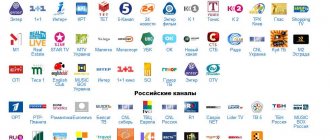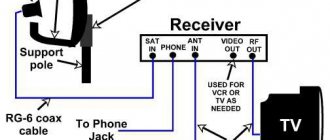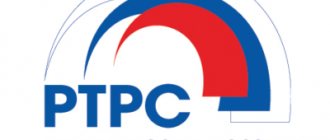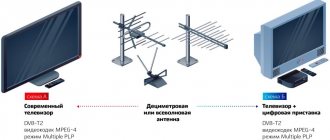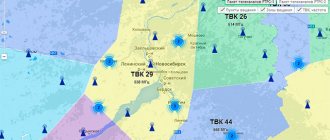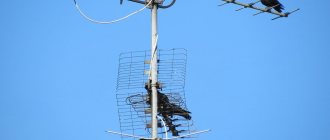SMOTRICIFRU.RF in Russia is a site for the transition from analogue broadcasting to digital terrestrial television. We will help you set up and connect digital channels. Technology does not stand still; every day society becomes more technologically advanced. Digital television moves with the times and is constantly evolving. Against this background, Russian television is switching to a digital broadcast format. DVB-T2 was approved as the standard for this digital television.
About the site
The Russian television and radio broadcasting network (this is the transcript of RTRS) is a state-owned unitary enterprise (abbreviated as FSUE). A presidential decree launched the company in 2001. The Russian state-owned enterprise has an official website.
At the top of the main page of the RTRS portal there is a drop-down menu with three sections (“For TV viewers”, “Professionals” and “Press Center”). After going to any of the sections, access to the “select your region” menu opens. It presents a list of regions, territories and republics in alphabetical order. The main navigation bar remains visible no matter which section is open. It looks like this.
Consulting support center
Consultations to the population on the problems of choosing and connecting receiving equipment are provided by the support center (abbreviated as TsKP). The digital TV website lists a 24-hour hotline number (8-800-220-20-02). Calls within Russia are free of charge. You can also use the feedback form (in the picture it is highlighted with a red rectangle). The section of the website with information about the CKP is located at https://rtrs.ru/tv/ckp/.
Is there digital television in your region?
You can determine whether there is a number in a particular region using a service - a coverage map. Its other name is the interactive map CETV (stands for digital terrestrial television). The service is located at https://map.rtrs.rf.
Digital television coverage map
The RTRS coverage map allows you to find out the signal source and the distance to the nearest tower. You can also see the frequency and channel of television broadcasting on the map. To use the coverage map, you must enter the address or name of the facility in the search bar. Another option is to click on the object found on the map to open an information window.
All the necessary information will be presented in the window that opens. The arrow with its black end indicates the direction to the nearest TV tower. This way you can determine the source of the signal from the map. When you click on the tower icon, the coverage area will open.
Installation location
Installation in the room. It’s worth clarifying right away that you can’t count on an excellent TV signal level for a large number of citizens. An “excellent” level will be if the TV tower is actually visible to you from your home. As you understand, a priori there cannot be many such zones. If you plan to conduct digital television outside the city, in a village or town, there is a 90% chance that a simple indoor antenna is a bad idea. The quality of the connection will be unstable, the picture will not be watchable.
Outdoor installation. It is chosen by the majority of citizens. Because such antennas are an excellent option for country houses, dachas, and even a number of villages. Outdoor antennas are also offered to urban citizens living in densely built-up areas. Install antennas on roofs and walls. Even a balcony may be suitable if there is free space. Attention! Self-installation is not recommended. You need to contact a specialist!
Collective antennas are common, especially in big cities. They are installed on the roof of a multi-story building. Thus, all its residents receive a television signal. If you live in a dense multi-storey building, this is one of the best choices.
What do you need to take RTRS?
The operating principle of digital television and radio broadcasting in our country is simple. Television towers installed throughout Russia transmit signals into the air in the form of electromagnetic waves. You can catch the signal and convert it into an image using the following equipment:
- antennas;
- TV;
- digital set-top box (you will need it if your TV model does not accept digital TV).
Attention! The main digital broadcasting format in Russia is the DVB T2 standard.
DVB T2 standard
The DVB digital television standard was developed by the DVB Project at the end of the last century. DVB is an abbreviation for the expression Digital Video Broadcasting (translated from English as “digital video broadcasting”). The letter T in the name of the standard refers to terrestrial broadcasting (in English Terrestrial). The number 2 denotes the second generation of the standard.
Select TV
The TV model and year of production affect the ability to receive a digital signal. If you are just about to purchase equipment, then it makes sense to choose one that is designed for the DVB T2 standard. On the website, see the figure of the Russian Federation in xlsx format, an Excel table is available for download. You can find the models you need there. In addition, the instructions for the TV always indicate the maintenance of new generation numbers.
If you already have a TV, but it does not support the specified standard, you will have to additionally purchase a set-top box. A table with a list of devices can be downloaded there.
Select console
A set-top box is a device that will receive a digital television signal, convert it (decode it) and transmit it to the TV. When choosing a model, pay attention to a number of important details.
- The set-top box (also called a receiver) should have the inscription DVB T2. Its presence indicates that the equipment can receive the desired signal. If there is no inscription, then the device may be fake. The presence of an RTRS certificate on the set-top box is indicated by the logo of the Russian television and radio network (in the form of a butterfly).
- The receiver is connected to the TV using an RCA-RCA cable (otherwise known as “tulips”) or an HDMI cable. Before purchasing, you should check whether the connecting elements are included in the kit.
- The power supply of the set-top box is another important element. Some models have a plug-in unit that can be easily replaced in case of breakdown. This option is more profitable. If the wire is built into the body of the set-top box, you cannot do without contacting service in the event of a breakdown.
- It is better to choose a control panel that is convenient, so before buying a receiver it makes sense to hold it in your hands.
- The presence of additional functions determines the price of the equipment. If the set-top box will be used to watch video from a flash drive, then you need to clarify whether Dolby Digital sound and video of various formats are supported.
- There should be a customer service nearby.
- Availability of reasoned positive reviews about the equipment on various Internet resources.
Select antenna
You can find the signal (i.e. electromagnetic waves) using an antenna. If the choice is made independently, you need to pay attention to a number of details.
- Tower location. If it is visible from the window, a small indoor antenna will do.
- Building density and floor. The walls of buildings create an obstacle in the path of the signal; it is reflected from them and changes direction. Residents of high-rise buildings and apartments on the lower floors are better off choosing an outdoor antenna or a collective one. They can be installed on the roof of the house.
- It makes sense to choose an antenna with an amplifier in difficult conditions (the tower is far away, the buildings are dense). High gain may cause interference. One solution is to check with your neighbors what they use.
- You need to check with the seller what frequencies the device receives. If decimeter, then the device is suitable only for numbers. If it is meter, then it is only suitable for analog channels.
Video instructions
There is a page on the Russian Federation website dedicated to troubleshooting. It is located at https://rtrs.ru/tv/video-guide/. The video discusses cases when digital television does not show at all, or there is interference in the transmission of image and sound. Possible ways to solve the problems that have arisen are also considered. Link to instructions in video format on Youtube channel:
.
How to choose an antenna
We have already noted the importance of the antenna. Let's look at it in a little more detail. TV antennas should be divided according to three (but not the only) key characteristics:
- Where will it be installed;
- What type of signal amplification;
- Received frequency range parameters.
That is, you first need to figure out the approximate distance of the antenna from the TV tower. Next, check the transmitter power. The height at which the antenna will be located plays an important role. That is, if you live on a high floor, and there are no dense buildings or unfavorable landscape outside your window, there will be no problems with signal quality. In the presence of domestic or industrial interference, heavy buildings, or a low antenna location, the signal quality drops significantly. If the receiving antenna is in close proximity to the transmitting station, then certain interference no longer plays such an important role.
Digital TV channels
According to presidential decree (No. 715 of October 24, 2009), 10 free channels are available in our country. They are included in the RTRS-1 package (the first multiplex). Between December 2012 and September 2015, 10 more channels were selected and included in the second multiplex.
First multiplex
The RTRS package, designated by number 1, includes:
- First channel;
- Russia 1;
- Russia-K;
- Russia 24;
- Match TV;
- NTV;
- Channel 5;
- Carousel;
- OTR;
- TV Center
In those regions where the previous standard (DVB-T) was recently in force, a transition to the new standard was carried out.
Second multiplex
Since 2015, the channels of the second package (RTRS-2) have also received the status of mandatory and publicly available. Based on the results of several competitive selections, this multiplex included the following channels:
- REN TV;
- Saved;
- STS;
- Home;
- TV-3;
- Friday!;
- Star;
- World;
- TNT;
- Muz TV.
A total of 20 TV channels are freely available. The second multiplex is not yet broadcast everywhere; completion of the network was planned for the end of 2021.
Third multiplex
The all-Russian launch of the third multiplex has been postponed for now by decision of the Ministry of Telecom and Mass Communications. It is assumed that this package will include 7-8 federal channels, 1-2 regional and one more channel, the development of which is entrusted to VGTRK (All-Russian State Television and Radio Company). The project was frozen for economic reasons.
The pioneers in introducing the third multiplex were the Republic of Crimea and Sevastopol. In these regions, at the time of joining the Russian Federation, 4 multiplexes were already operating. The third is represented by regional channels - “First Crimean”, “First Sevastopol”, “Millet”, “Moscow 24”, “Mir 24”.
Radio
Digital broadcasting involves the use of a broadcast frequency. We are talking about radio and three radio channels of universal free access - Radio Russia, Mayak and Vesti FM.
Analog channels
Such channels are a simple version of terrestrial television broadcasting; they operate using an analog signal. The signal is capricious in relation to the receiving device - the antenna. The location relative to the TV tower plays a role. Interference on analogue channels is a common occurrence, especially when it comes to transmission over meter waves (MV range).
The final transition to digital television in Russia is planned for 2021. This topic is actively discussed on the RTRS forum. The resource was created for technical employees of the company. The countdown to the shutdown of analogue TV channels by region is presented on the main page of the website, see the figure in the “TV viewers” section.
Received frequencies
All-wave antennas are the most common. Since they are ways to work with both the VHF and UHF bands. Thus, the user gets access to all Russian TV channels. In today's realities, some channels operate in the VHF range, while others operate in the UHF range.
UHF antennas - they can only receive digital terrestrial TV signals. The waves are received at ultra-high frequencies.
It makes no sense to talk about meter antennas in detail. They are absolutely not suitable for digital television.
Prevention
Preventative work is carried out according to plan and is aimed at checking equipment and replacing failed elements of the broadcast system. During such work, the equipment is turned off, there is no broadcast, and the TV viewer does not see the program on the channels. The company warns about planned outages in advance; on the official website of RTRS of the Russian Federation there is a separate page with a table (schedule) of outages for the region. It is located at https://rtrs.ru/tv/breaks/, it states:
- the point where the broadcast will be turned off;
- shutdown date;
- packages of channels not broadcast on this day (multiplexes RTRS-1 and RTRS-2);
- estimated work time.
Attention! The official DTV website provides information about prevention in the news feed. The ad looks like this.
Key antenna specifications
Any type of antenna is equipment, and accordingly, it has technical characteristics. What should the buyer pay attention to? Consumers mistakenly focus on decibels. They are certainly important. But you should first consult with a specialist who will select the best place to install the antenna. After determining the location for installation, the technician will be able to clarify which decibel antenna should be purchased. A common misconception among buyers is that the higher the dB, the guaranteed better the signal. Against! If the indicator is too high, the TV picture may be distorted.
When purchasing an antenna, you receive a model passport and detailed instructions. The instructions will tell you where it is best to install the product and how to connect it to the TV. If you are not doing the installation yourself, your technician may need instructions.
Branches
The Russian television and radio network has 78 branches throughout the country. The Federal Unitary Enterprise as a legal entity has the following TIN 7717127211. The company's headquarters is located in Moscow, and the operator in the capital and region is the branch of RTRS "MRTs". Depending on the selected region, the corresponding name appears before the all-Russian rtrs.ru (for example, for the Trans-Baikal Territory the address looks like this - chita.rtrs.ru, for the Chukotka Autonomous Okrug - chukotka.rtrs.ru).
Vacancies
The RTRS vacancies section is located at https://rtrs.ru/tv/vacancies/. The page displays all available positions in the country, or only regional ones. The region can be selected in the drop-down menu (this was discussed at the beginning of the article).
The text of the advertisements states:
- requirements for the employee;
- his job responsibilities;
- employer conditions;
- email address for sending your resume;
- HR specialist contact details.
The picture presented shows that there are no jobs offered for Moscow at the time of writing, there are no vacancies.
Management
The General Director of RTS is Andrey Yurievich Romanchenko, who was appointed to this position in May 2010. The first deputy general director for economic and financial issues is Alexey Yurievich Popov. Pinchuk Viktor Nikolaevich acts as first deputy for management, operation and development of the network.
Information about other deputies can be obtained in the section “RTRS Management” (indicated by number 1 in the picture), information about the heads of branches is in another section (number 2 in the picture). The content of the page that opens will depend on which region from the list was selected in advance.
FAQ
A list of frequently asked questions and answers to each of them are presented in the “Feedback” section. TV viewers are interested in the following:
- what are the advantages of digital television compared to analogue;
- how to start watching digital TV;
- time of appearance of the second multiplex in a specific locality;
- the ability to connect several TVs to one set-top box;
- what is the phenomenon of interference, etc.
If the answers you are looking for are not among those listed on the page, you can use the feedback form.
Connect the set-top box to the TV
When connecting the set-top box to an analog TV yourself, you should also perform 5 simple steps:
- Disconnect the TV from the mains;
- Connect the cable from the antenna to a special input on the set-top box, then alternately connect the cables responsible for audio and video;
- Restore power from the network;
- In the settings on the TV, select the connected connectors;
- Select automatic or manual search for digital channels.
